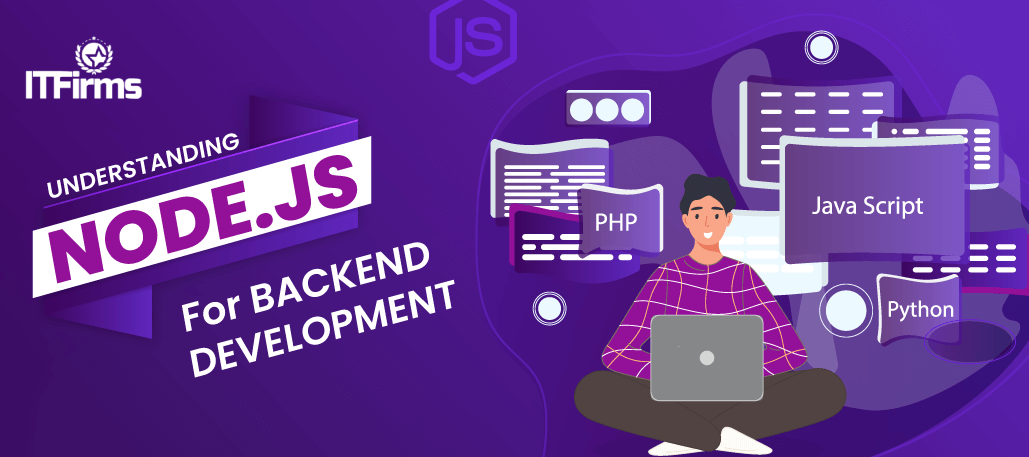
Understanding Node.js for Backend Development
Let’s first dive into how Node.js works? We’ll subsequently understand what it is, why is it prevalent? What are the applications? Are there any alternatives to it?
Node.js can utilize APIs to handle HTTP requests, file systems, and server-side features. It does not limit its capability to the front-end operation mode. It applies JavaScript for creating an internal code-base to develop the front-end.
What is Node.js?
It is an open-source runtime environment for creating the back end of web applications. It uses WebSockets/sockets.io to create basic interactive customer service or live chat applications. It installs the socket.io library on the webserver and the client and creates event emitters and broadcasters that push messages across the ‘WebSockets open connection. It accomplishes this basic functionality in just a few lines of code.
Additionally, Node.js assists in developing single-page applications by loading all client-side scripts into a single HTML page that works as the main entry point into the entire application. All partial views load into this central template on-demand. The AJAX requests in the background ensure that the application updates without reloading the webpage.
Node.js handles asynchronous calls and heavy I/O workloads efficiently.
You may use frameworks like Express (or any other JavaScript framework for the web) available via the NPM repository to turn Node.JS into a REST API streaming data and services from specific routes.
This process reduces the server’s load and ensures API sharing across different applications and environments. Node.js returns the index page (index.HTML), sending data via REST interfaces and controllers on the server-side.This approach also ensures a clear separation of concerns (SoC) between models, controllers, and views with all the data relating to the services implemented on the server-side.
Node.js comes with asynchronous and event-based architecture to offer a wide variety of software solutions for co-browsing, video, and audio conferencing, project management, application sharing, and collaborative editing of documents via Real-Time Collaboration Tools.
Node’s WebSockets and Event API ensure heavy I/O operations preventing the server from getting hung up and share all the data with the clients in time.
Push Notifications is a primary feature of Node.js. It instantly updates the collaboration environment for a single and coherent representation of the application.
Where is it useful?
- It does not obstruct I/O and serves multiple simultaneous requests.
- It makes it easy to scale the technology and handle high-load platforms.
- It is flexible to meet user demand.
- It has a responsive runtime environment that provides easier access to information and services.
- Node.js promotes an organized front-end and back-end environment.
- Node.js projects are lightweight, which do not require big-size or multiple teams. It thereby saves costs and time.
- Node has JavaScript at its core, making it convenient and super-easy to understand, accelerating the app creation process.
- It does not require expensive licensing.
- It is pretty easy to troubleshoot.
When should you use Node.js?
If you want your app to run in real-time and process multiple client requests, you may consider Node.js. It supports WebSockets via libraries as socket.io, ws or WebSocket-node that help deploy efficient real-time chats and applications.
It brings in a baffling user experience and prompts response time. But it is not suitable for applications that require high security – live chats and instant messaging apps, video games, collaborative platforms, online games, and social media.
Which Node.js applications are prevalent?
Node.js is a cross-platform app development framework that has been used by – (1) Paypal, (2) NASA, (3) Uber, (4) eBay, (5) Facebook, (6) Amazon, (7) Netflix (SPA), (8) LinkedIn (SPA), (9) Medium (SPA), (10) Slack (Real-Time Collaboration Tools), (11) Trello (Real-Time Collaboration Tools ), (12) Google Docs (Real-Time Collaboration Tools), (13) Streaming Applications etc. and in building real-time chat applications, real-time collaboration tools, Micro-services Architecture, Internet of Things devices like sensors, beacons, actuators, embedded electronics that enable sending and receiving data, complex single-page applications.
What can you use instead of Node.js?
Node.js performs better than similar high-end programming platforms like Ruby on Rails; it efficiently handles multiple requests and responds to each one of these swiftly. For this reason, it is a deal for client-focused web applications.
In Conclusion
Node.js works on a single thread. It is suitable for conventional web apps and Back end API services that run in real-time. It enables you to deploy code to both the client and server sides, bridging the gap between front-end and Back end development. Node Package Manager helps to access many tools and modules to use to your advantage. Node.js code executes quite quickly in comparison to many other programming languages. For this reason, it is preferable to develop micro-services for developing enterprise applications.
Node.js development companies owe for a single-threaded solution and might become unresponsive in case of large files. Conventional multi-threaded solutions perform better in the case of big projects. We hope this excerpt brings some clarity and facilitates Node.js App Development for your Node.js developers.
